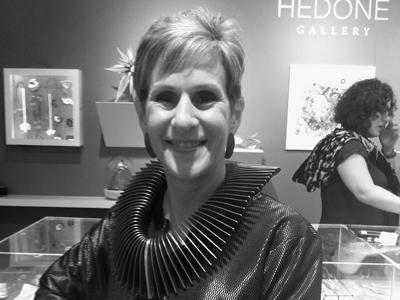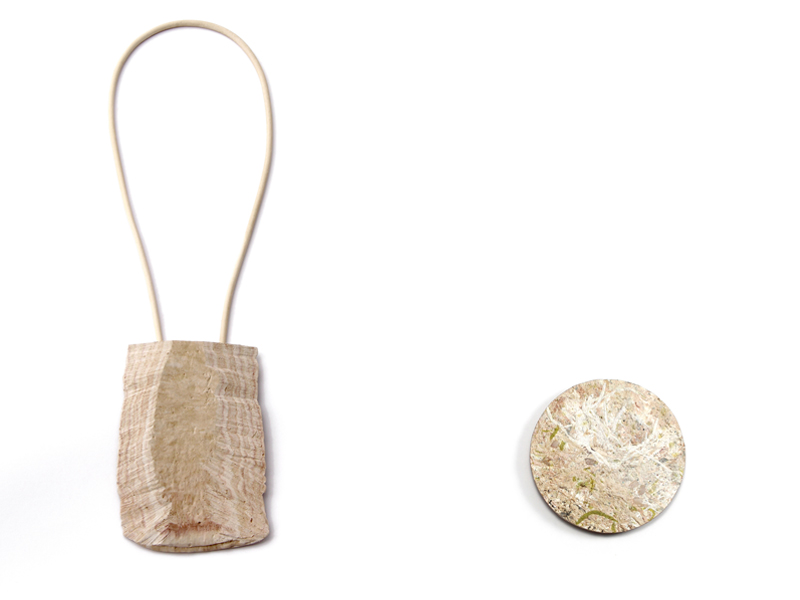
Growing up surrounded by the beauty of rural New Zealand, Debbie Adamson has been profoundly affected by the magic of the landscape, ocean, wildlife, and history of her homeland. This connection to place is reflected in her jewelry, made mostly of synthetic materials because they, too, are part of the landscape that we often take for granted. Does this connection between place and materials portend deeper consequences and impacts on that beloved land? Debbie examines this question in her recent exhibition at Avid Gallery, Accumulations of Plastic Matter.
Bonnie Levine: You grew up in very rural Central Otago, New Zealand, known for its vast landscapes, rugged mountains, gorges, valleys, and rivers. Tell us about your childhood memories growing up there. You describe having a “strong, somewhat contradictory, connection to the land.” What does that mean exactly, and how does it influence you today?
Debbie Adamson: I was lucky to have a childhood that felt really free.
The family home was in a small community with 20 or so other houses just off the main highway. One of my earliest memories is of the railway line and goods train that would travel through the area. It stopped outside our house once so the driver could get out and buy some honey from my parents. When I was two or three, the line closed; it was derelict for years, but eventually they turned it into a cycle trail, so there are lots of tourists biking through now.
From the age of about five, I have quite specific memories. We had a beautiful backdrop of mountains, but I took them for granted and was much more interested in things on a micro level—the creek below our house with its many inhabitants, ant farms, birds’ nests, trees, rabbits, and so on. It was an outdoorsy childhood, and my sister and I would just wander around exploring (sometimes quite far from the house) for hours.
As I’ve grown older, I cherish these recollections, but I’ve come to realize how romantic they are. I still feel a strong connection to landscape, but I had this idea about it that’s not really real—a perception that it was somehow wild and untamed, yet belonged to me one way or another. My understanding now is also tinged with the realization that many of the agricultural activities I grew up surrounded by are contributing to ecological harm.
On a deeper level, I also feel the weight of New Zealand’s colonial history. The name of the area where I lived is called the Maniototo, which is probably a contraction of the Māori word Mānia-o-toto, meaning “plain of blood.” It was an area that Māori travelled through on their trails to collect pounamu (nephrite jade), and in pre-European times it was covered in flowing red tussock. The sight of this vegetation, which was later destroyed by fires in the region, is generally thought to be the origin of the name. The land is stripped bare of tussock now, and to this pākehā[1] artist, it is hard not to connect the words “plain of blood” to the conflict between the Māori and colonial settlers, following the latter’s arrival in New Zealand, and the signing of the Treaty of Waitangi. Mistranslation, sovereignty, and ownership of land have been huge issues (among others), and the conversation is ongoing.
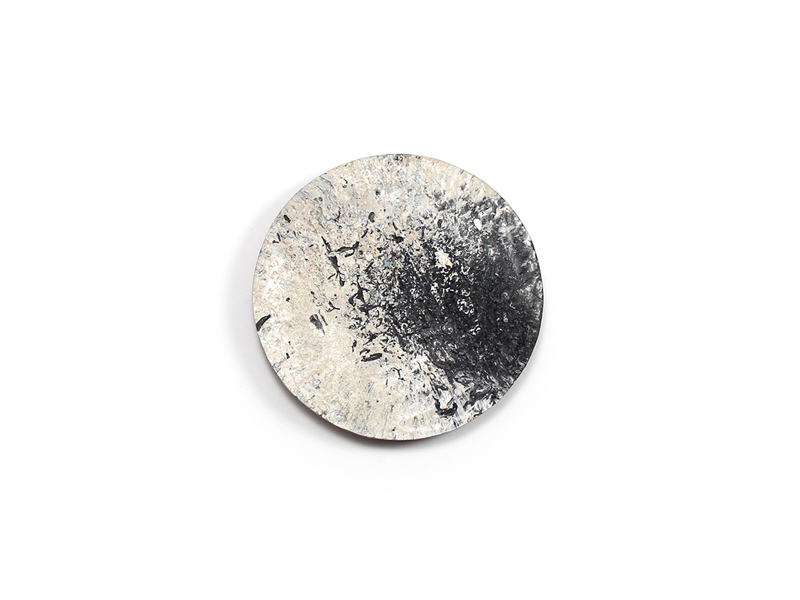
Did your upbringing influence your interest in making jewelry? You’ve said that your most memorable encounter with metal is not in jewelry, but in your father’s workshop. What is his background? Is he an artist?
Debbie Adamson: No, he is not an artist; my father is a beekeeper. Growing up, this was the family’s livelihood. Summer was always busy in the field, but Dad would always spend winters (the off season) in his workshop. He’d be making and modifying things for the honey house, improving equipment and fixing bits. The shed was always full of bee boxes, materials, odds and ends, things in various states of repair, and strange pieces waiting to become useful.
I never had an inkling that I would become a jeweler or artist of any sort, but I think I was always in close proximity to people working physically to produce things, and always looking closely at my surroundings.
I went directly from high school into a BFA program at Otago Polytechnic, where I eventually ended up in the jewelry department.

Shortly after graduating from college, you were selected to participate in an innovative development project called Handshake, which paired young New Zealand artists with their heroes in the international jewelry world for a two-year mentoring program. In your case, this took the form of an online exchange. Who was your hero, and why? Tell us about that collaboration, and what it meant for you and your development as a maker.
Debbie Adamson: For Handshake 1 I worked with Swedish artist Hanna Hedman. You will be familiar with her work because she designed the 2016 pin for AJF.
I was introduced to Hanna’s work when I was at art school, partly because she had also spent time at Otago Polytechnic a few years before. There is a beautiful little piece of her early work in the jewelry department collection, made from painted fish bones and thread. When I first saw her metal works, I found myself really fascinated by her decorative forms; they are so layered, textured, and detailed, filled with unexpected shapes and references. I was and still am very intrigued by these pieces.
At the time of this project, I was feeling quite uncertain about my direction as a maker, so we dealt with this through an experiment where I borrowed Hanna’s methodology for making work, which was actually quite confronting for both of us. Coincidentally, I noticed that many of the other pairs in Handshake experienced something similar along the way, reaching a point where they questioned themselves. I think one of the challenges in learning and collaborating is understanding your own voice, and at times letting go of your own preconceptions to see what happens next.
Hanna was a very supportive mentor, and it was really lovely to finally meet her in person when I eventually traveled to Munich. By the end of the project I realized how much I was longing to be able to just go for a coffee [with her] and have a chat instead of sitting down at the computer! Still, technology is a pretty marvelous thing.
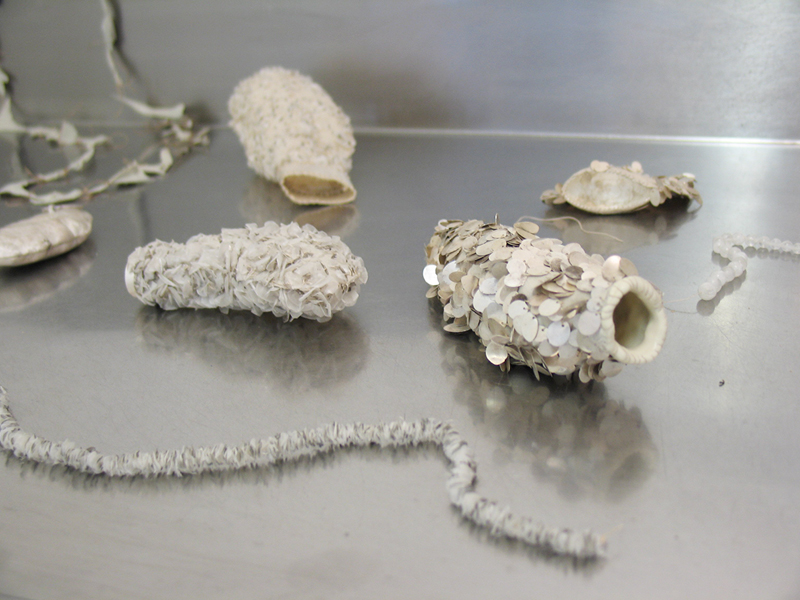
Early in your career, you also spent time working in the New Zealand workshop of goldsmith Kobi Bosshard, a third-generation Swiss goldsmith who was among the first contemporary jewelers in New Zealand. What was it like working for such a master goldsmith? What did you learn that you’ve carried into your own practice? Are there references to his work in yours?
Debbie Adamson: It was a real privilege to spend time working with Kobi and also get to know his partner, Patricia (they are both in their 70s now). They are both incredible people. Kobi, as you mentioned, is a third-generation Swiss goldsmith, and Patricia was a pioneer in the New Zealand art scene during the 70s and 80s (the driving force behind their joint Dunedin venture, Bosshard Galleries), and is now a practitioner herself in the field of weaving.
The experience had quite a profound effect on me because I was not only working in the workshop but also living with them, staying in a tiny converted bus on the edge of their property and sharing meals, week in, week out, for nearly 18 months. I feel a bit emotional when I think about it because while I did learn a lot of skills, it’s the things that weren’t said that have had the most impact. Kobi and Patricia both have a real vigor for living, passion for the arts, and energy for debate. They are both still working, and I think this ethic toward work and life is part of what sustains them. I hope it is what will continue to influence me the most.
Unlike Kobi Bosshard’s use of metal in his work, most of your jewelry is made with synthetic materials—plastic, rubber, chicken wire, barbed fencing wire. What interests you about these materials? How do they mark your relationship to place? To preciousness?
Debbie Adamson: I’ve actually made a lot of work with metal but exhibited it less, and some of it is heavily influenced by Kobi’s work.
My use of alternative materials started when I was at art school and reflecting on my own background. I was interested in man-made constructs and chose materials I had encountered in the farming environment, wanting to see what would happen if I explored the use of them within a jewelry context. So in terms of synthetic materials, I literally started by playing with rubber from a rain boot (or what we call a gumboot).
For me it was not so much about critiquing preciousness (which I assumed), but about finding some kind of meaning or life in these materials, which I guess has carried on throughout my practice. Recently it feels like I have cycled ’round and am ready to start exploring through more of a conceptual framework (earlier in the year I collaborated with another artist to make a small book and we had a lot of conversations around this), but I think the urge to work with material and process will always be quite strong and evident in my work.
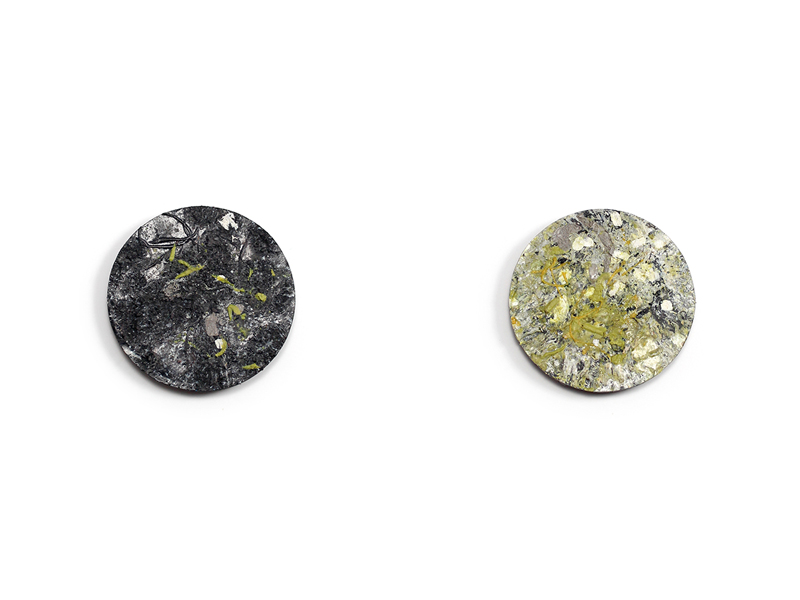
Your recent bodies of work are made of plastic, a man-made material that has become integral to our functioning in society yet has serious consequences and implications. By using this material, are you making references to consumerism and the degradation of the environment?
Debbie Adamson: Particularly at this point in time, I think these issues are almost inherent in plastic, so I would say yes. But I also wanted to approach it as a material in its own right, to see what could be drawn out of it. I guess most of what I have done has its grounding in material. I tend to focus quite exclusively on something and develop works through a combination of process and subjective insight: experimenting, researching, and finding forms or references from my immediate surroundings. Does that make sense?
Your recent show at Avid Gallery was called Accumulations of Plastic Matter. It’s an interesting play on words. What was your inspiration for the show, and what work did you present?
Debbie Adamson: I borrowed my title from a recent book, Accumulation: The Material Politics of Plastic, edited by Jennifer Gabrys, Gay Hawkins, and Mike Michael. Though I have not managed to look at a hard copy of the text, the snippets I could read online provided very interesting insights into the complex issues which surround the material. There is this idea that plastic is somehow emblematic of our age, in that (particularly in the western world) it implicates what you mentioned earlier, economies of both abundance and ecological destruction. I thought that was pretty interesting.
The work that really came out of this was the series of brooches I made using dust and off-cuts, mostly PVC, left over from various projects. Perhaps this is where the goldsmithing background had quite a direct influence: Every time I make something there is this urge to conserve material, collect the filings, and gather up the rejects. I had amassed bags and bags of this “precious” plastic material, and didn’t really know what to do with it. It just kept moving with me. The idea of melting or reconstituting it somehow was always there, but it wasn’t until I read the excerpts from this book and started looking at what happens to plastic as it degrades that I decided to experiment with it.
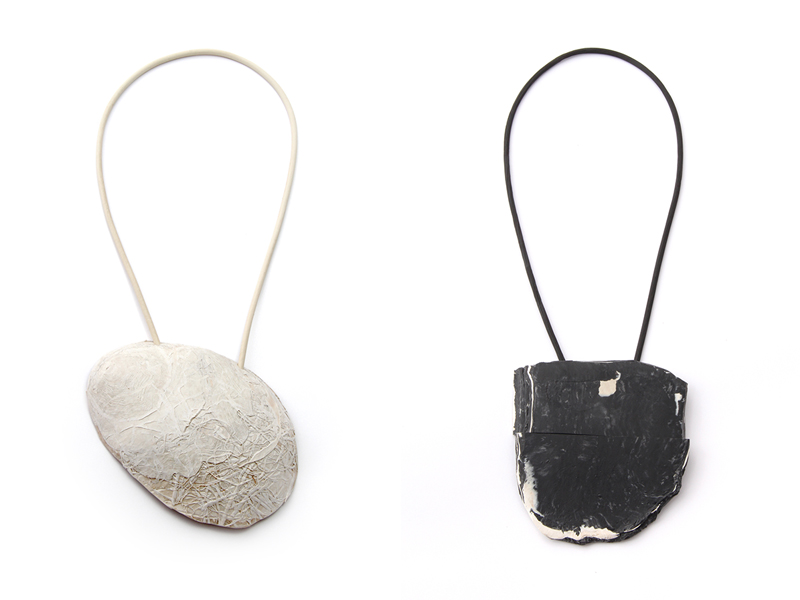
Your circular brooches look like trompe l’œil planetary surfaces: They exist as recycled plastic objects and evoke outer space. Was that intentional?
Debbie Adamson: The texture and surface of these brooches is very much a result of the process, but I deliberately didn’t want them to have the slick, clean finish we are used to with consumer plastic objects. To me the process of making them was a bit like painting. They have layers and layers and end up looking quite abstract, so I decided to define them by making quite strong shapes. At home we have a lot of core samples around (from drilling), and I was looking at these while I was working, so I think there might be something to your observation.
What’s next for you? Do you have specific goals for the next five years?
Debbie Adamson: I am currently working on projects within the Handshake 3 platform. We have a show opening at Platina in Stockholm this month, a collaboration with Dialogue Collective in the making for Schmuck 2017, and a final exhibition for the project at the Dowse Museum in Wellington scheduled late next year.
My biggest ambition is always to keep moving with my practice, hopefully making better work as I go along.
What have you seen, read, heard, or experienced recently that you’d like to share with our readers?
Debbie Adamson: I was recently on a flight and decided to buy a collection of short stories titled Gorse Is Not People, by the New Zealand author Janet Frame. Some of them are really sad, but I’ve always wanted to read her work, and I enjoyed this little book.
Thank you.
The work in this exhibit ranges in price between NZ$330 and $600.
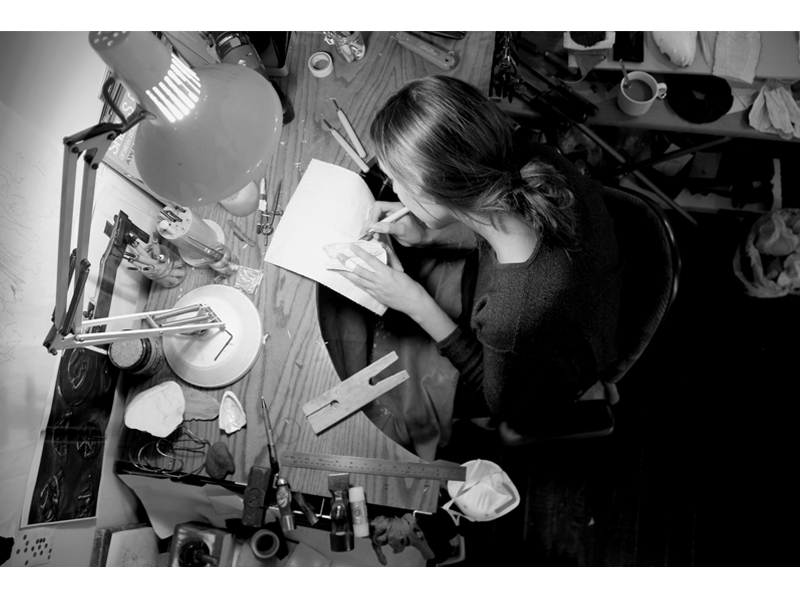
INDEX IMAGE: Debbie Adamson, Brooch: Accumulations Blue, 2016, plastic, copper, steel, 80 x 80 x 10 mm, photo: artist
[1] Of European descent
